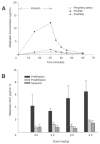Phase I study of hepatic arterial melphalan infusion and hepatic venous hemofiltration using percutaneously placed catheters in patients with unresectable hepatic malignancies
- PMID: 15908655
- PMCID: PMC2374756
- DOI: 10.1200/JCO.2005.00.927
Phase I study of hepatic arterial melphalan infusion and hepatic venous hemofiltration using percutaneously placed catheters in patients with unresectable hepatic malignancies
Abstract
Purpose: We conducted a phase I study of a 30-minute hepatic artery infusion of melphalan via a percutaneously placed catheter and hepatic venous hemofiltration using a double balloon catheter positioned in the retrohepatic inferior vena cava to shunt hepatic venous effluent through an activated charcoal filter and then to the systemic circulation. The purpose of the study was to demonstrate feasibility in an initial cohort and subsequently determine the maximum tolerated dose and dose-limiting toxicity of melphalan.
Patients and methods: The initial cohort (n = 12) was treated with 2.0 mg/kg of melphalan before dose escalation to 3.5 mg/kg (n = 16). Total hepatic drug delivery, systemic levels, and percent filter efficiency were determined. Patients were assessed for hepatic and systemic toxicity and response.
Results: A total of 74 treatments were administered to 28 patients. Twelve patients with primary and metastatic hepatic tumors received 30 treatments (mean, 2.5 per patient) at an initial melphalan dose of 2.0 mg/kg. At 3.5 mg/kg, a dose-limiting toxicity (neutropenia and/or thrombocytopenia) was observed in two of six patients. Transient grade 3/4 hepatic and systemic toxicity was seen after 19% and 66% of treatments, respectively. An overall radiographic response rate of 30% was observed in treated patients. In the 10 patients with ocular melanoma, a 50% overall response rate was observed, including two complete responses.
Conclusion: Delivery of melphalan via this system is feasible, with limited, manageable toxicity and evidence of substantial antitumor activity; 3 mg/kg is the maximum safe tolerated dose of melphalan administered via this technique.
Figures



Similar articles
-
Complete hepatic venous isolation and extracorporeal chemofiltration as treatment for human hepatocellular carcinoma: a phase I study.Ann Surg Oncol. 1994 Sep;1(5):389-99. doi: 10.1007/BF02303811. Ann Surg Oncol. 1994. PMID: 7850540 Clinical Trial.
-
Safety of Percutaneous Hepatic Perfusion with Melphalan in Patients with Unresectable Liver Metastases from Ocular Melanoma Using the Delcath Systems' Second-Generation Hemofiltration System: A Prospective Non-randomized Phase II Trial.Cardiovasc Intervent Radiol. 2019 Jun;42(6):841-852. doi: 10.1007/s00270-019-02177-x. Epub 2019 Feb 14. Cardiovasc Intervent Radiol. 2019. PMID: 30767147 Free PMC article. Clinical Trial.
-
Prospective Clinical and Pharmacological Evaluation of the Delcath System's Second-Generation (GEN2) Hemofiltration System in Patients Undergoing Percutaneous Hepatic Perfusion with Melphalan.Cardiovasc Intervent Radiol. 2017 Aug;40(8):1196-1205. doi: 10.1007/s00270-017-1630-4. Epub 2017 Apr 27. Cardiovasc Intervent Radiol. 2017. PMID: 28451811 Free PMC article. Clinical Trial.
-
Chemosaturation with percutaneous hepatic perfusions of melphalan for hepatic metastases: experience from two European centers.Rofo. 2014 Oct;186(10):937-44. doi: 10.1055/s-0034-1366081. Epub 2014 Apr 11. Rofo. 2014. PMID: 24729409 Clinical Trial.
-
Isolated liver perfusion for non-resectable liver tumours: a review.Eur J Surg Oncol. 2002 Dec;28(8):875-90. doi: 10.1053/ejso.2002.1328. Eur J Surg Oncol. 2002. PMID: 12477481 Review.
Cited by
-
Chemosaturation with percutaneous hepatic perfusion is effective in patients with ocular melanoma and cholangiocarcinoma.J Cancer Res Clin Oncol. 2020 Nov;146(11):3003-3012. doi: 10.1007/s00432-020-03289-5. Epub 2020 Jun 20. J Cancer Res Clin Oncol. 2020. PMID: 32564137 Free PMC article.
-
Percutaneous Hepatic Perfusion with Melphalan in Patients with Unresectable Ocular Melanoma Metastases Confined to the Liver: A Prospective Phase II Study.Ann Surg Oncol. 2021 Feb;28(2):1130-1141. doi: 10.1245/s10434-020-08741-x. Epub 2020 Aug 5. Ann Surg Oncol. 2021. PMID: 32761328 Free PMC article. Clinical Trial.
-
Prospective evaluation of percutaneous hepatic perfusion with melphalan as a treatment for unresectable liver metastases from colorectal cancer.PLoS One. 2022 Jan 13;17(1):e0261939. doi: 10.1371/journal.pone.0261939. eCollection 2022. PLoS One. 2022. PMID: 35025911 Free PMC article.
-
A New Option for the Treatment of Intrahepatic Cholangiocarcinoma: Percutaneous Hepatic Perfusion with CHEMOSAT Delivery System.Cells. 2021 Jan 5;10(1):70. doi: 10.3390/cells10010070. Cells. 2021. PMID: 33466278 Free PMC article. Review.
-
Combining Hepatic Percutaneous Perfusion with Ipilimumab plus Nivolumab in advanced uveal melanoma (CHOPIN): study protocol for a phase Ib/randomized phase II trial.Trials. 2022 Feb 13;23(1):137. doi: 10.1186/s13063-022-06036-y. Trials. 2022. PMID: 35152908 Free PMC article.
References
-
- Jemal A, Murray T, Samuels A, et al. Cancer statistics, 2003. CA Cancer J Clin. 2003;53:5–26. - PubMed
-
- Rothenberg MC, Oza AM, Bigelow RH, et al. Superiority of oxaliplatin and fluourouracilleucovorin compared with either therapy alone in patients with progressive colorectal cancer after irinotecan and fluorouracil-leucovorin: Interim results of a phase III trial. J Clin Oncol. 2003;21:2059–2069. - PubMed
-
- Kemeny N, Gonen M, Sullivan D, et al. Phase I study of hepatic arterial infusion of floxuridine and dexamethasone with systemic irinotecan for unresectable hepatic metastases from colorectal cancer. J Clin Oncol. 2001;19:2687–2695. - PubMed
-
- Egan KM, Seddon JM, Glynn RJ, et al. Epidemiologic aspects of uveal melanoma. Surv Ophthalmol. 1988;32:239–251. - PubMed
-
- Gragoudas ES, Egan KM, Seddon JM, et al. Survival of patients with metastases from uveal melanoma. Ophthalmology. 1991;98:383–390. - PubMed
Publication types
MeSH terms
Substances
Grants and funding
LinkOut - more resources
Full Text Sources
Other Literature Sources
Medical

